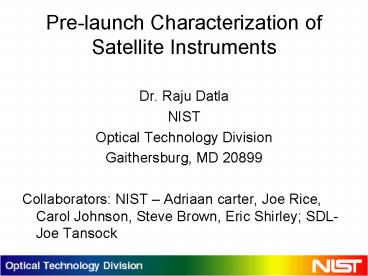Prelaunch Characterization of Satellite Instruments - PowerPoint PPT Presentation
1 / 17
Title:
Prelaunch Characterization of Satellite Instruments
Description:
Ocean Color with Sea-Viewing Wide Field of View Sensor (SeaWiFS) ... BuoY (MOBY) vicarious calibration facility in Lanai, Hawaii was supported ... – PowerPoint PPT presentation
Number of Views:57
Avg rating:3.0/5.0
Title: Prelaunch Characterization of Satellite Instruments
1
Pre-launch Characterization of Satellite
Instruments
- Dr. Raju Datla
- NIST
- Optical Technology Division
- Gaithersburg, MD 20899
- Collaborators NIST Adriaan carter, Joe Rice,
Carol Johnson, Steve Brown, Eric Shirley SDL-
Joe Tansock
2
Outline
- Calibration Planning and Implementation
- Subsystem/Component Characterization
- System Level Characterization
- Summary
3
Calibration Planning
- Start as soon as possible (i.e. requirements
definition, concept design, sensor design, etc.) - Encourage optimum sensor design and calibration
approach to achieve performance requirements - Use NIST as a resource to shake out problems
4
- Aperture diameter uncertainty is typically no
better than 1 micro meter. - NIST can measure apertures down to 3 mm
diameter to 0.05 micro meters. - Apertures are susceptible to unintended
obstructions and if thin, can warp.
5
3D Aperture Measurement
6
Blackbody Calibration at the LBIR Facility
7
Calibration Planning
- Identify instrument requirements that drive
calibration - Programs often start with a requirement such as
- Radiance Accuracy lt 5 absolute each band
Between Band lt 5 relative band to band etc. - NIST VXR 1s (2) NIST Trap Detector 1s (0.1)
- Perform trade study to determine best calibration
approach
8
Ocean Color with Sea-Viewing Wide Field of View
Sensor (SeaWiFS)
- Pre-launch Calibration Implementation
- A complete calibration and validation plan was
developed, funded, and implemented - Well defined measurement protocols were
established and documented in the archival
literature or as NASA TMs http//oceancolor.gsfc
.nasa.gov/DOCS/ - Sensor was characterized and calibrated by the
vendor using traditional techniques in the
laboratory, with government oversight.
9
Ocean Color with SeaWiFS Example of Rigor
- Pre-launch
- Sensor design included on orbit techniques
(solar illuminated reflectance standard, planned
lunar observations, channel for atmospheric
characterization, planned observations of in situ
vicarious calibration site) - The development of the Marine Optical BuoY (MOBY)
vicarious calibration facility in Lanai, Hawaii
was supported - NIST was funded to develop a stable, calibrated
six channel filter radiometer (SeaWiFS Transfer
Radiometer, SXR)
10
Ocean Color with SeaWiFS Example of Rigor
- Pre-launch
- NIST calibrated the integrating sphere used to
calibrate SeaWiFS - NIST participated in the pre-launch radiometric
calibration at the spacecraft integrator facility
11
Subsystem/Component Measurements
- Subsystem and/or component level measurements
- Help verify, understand, and predict performance
- Minimize schedule risk during system assembly
- Identifies problems at lowest level of assembly
- Minimizes schedule impact by minimizing
disassembly effort to fix a problem - System/Sensor level model development and
measurements - Allow for the development of Measurement Equation
and Performance prediction - Allow for end-to-end measurements
- Account for interactions between subsystems and
components that are difficult to predict
12
Ground Calibration
- Provides complete calibration needed to meet
related requirements - Is performed under conditions that simulate
operational conditions for intended
application/measurement - Careful in-lab calibration minimizes problems
that arise after launch - Minimizes risk of not discovering a problem prior
to launch - Promotes mission success during on-orbit
operations - Best to perform ground calibration at highest
level of assembly possible - Sensor-level at a minimum is recommended
13
Example of NISTAR- Radiometer built to look at
Earth from L1
14
NISTAR Has Three Spectral Bands
15
NISTAR Irradiance Mode Calibration at the SIRCUS
Facility
During calibration of NISTAR at the SIRCUS
facility, the instrument was in a thermal-vacuum
chamber to simulate the space environment. It
viewed the output of a laser- illuminated
integrating sphere (green), simulating the
geometry of the view of Earth from L1.
The integrating sphere was on a translation
stage, and the laser was fiber-optically fed.
This enabled the source-to-detector distance to
be varied. For filter transmittance
measurements, the sphere was at the focus of a
collimator.
16
Results and Comments
- Piece-parts filter transmittance can be off by
0.1 or more. - Piece-parts absolute calibration can be off by
0.1 or more. - System level characterization using tunable
lasers at facilities such as SIRCUS can be used
for higher accuracy, higher-confidence
system-level calibration. - Important to wedge radiometer optics (such as
filters) to enable best SIRCUS calibration. - At SIRCUS, absolute radiometric calibration
traceability is through irradiance trap detector.
17
Summary
- Pre-Launch Characterization































